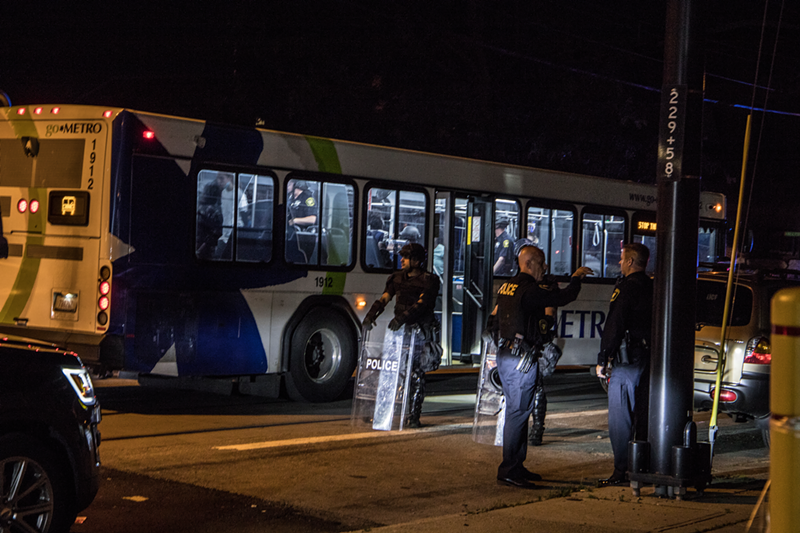In order to comply with Mayor John Cranley's citywide curfew — in effect from 9 p.m.-6 a.m. Sunday, May 31 and Monday, June 1 — Metro suspended its bus service last night and will do so again tonight.
The curfew did not just apply to people on the streets, but also those in cars, on motorcycles or other vehicles. But city officials, members of public safety forces, emergency personnel, health care professionals, essential workers, those experiencing homelessness or local government officials engaged in lawful duties were exempt from the order.
So, if you happened to be any of those above who relied on the tax-funded bus system for transportation, you had to find another means of getting around last night (and tonight). Like, if you were an essential worker whose shift ended after 9 p.m., you would suddenly be stranded without your regular transport option.
That didn't sit well with some, including transit activist and Better Bus Coalition president Cam Hardy.
How do they expect essential workers to get home after 9pm? Walk. Then get swooped up by CPD for being out past curfew. Asking a 65 year old woman to walk home after a 12 hour shift is wrong. https://t.co/DLOK5Ph4sZ
— Cam 🚍🚍🚌🚏 (@camhardy513) May 31, 2020
Hardy also said, "Shutting down metro tonight doesn't show me that black lives matter."
Later in the night, the Cincinnati Police Department and the city started using those out-of-operation Metro buses for another purpose: to transport arrested protestors to the Hamilton County Justice Center.
Reporter Nick Swartsell saw protestors being put on four separate Metro buses.
— Nick Swartsell (@nswartsell) June 1, 2020
Again, another decision that infuriated many, including Hardy.
I'm livid. People were stranded last night. Buses stopped running at 9pm. I was willing to accept that for the sake of operators safety. But then @KregKeesee comes up with an idea to hand our bus system off to the cops and force supervisors to drive the buses! INSANE.
— Cam 🚍🚍🚌🚏 (@camhardy513) June 1, 2020
Metro is a public government entity it shouldnt be used in the manner it was used last night.
— Cam 🚍🚍🚌🚏 (@camhardy513) June 1, 2020
Troy Miller, President/Business Agent of the Amalgamated Transit Union Local 627, said, "Our buses are not for hauling people arrested. And I'm not supporting that."
Miller says Mayor Cranley called him around 10:30 p.m. last night to ask if the drivers could operate the Metro for those reasons, and Miller said no because the union operators were off work at that time and because it would put his people at risk. After their discussion, Miller says Cranley went to the SORTA board, which includes chair Kreg Keesee mentioned in Hardy's tweets, to secure drivers.
"No organized labor was involved in that last night," Miller says. "I want that message out there because our drivers are all organized, they all represent the public."
"They shut the service down and turn around and go and do that. It sends the wrong message to the public," he says.
Here is Metro's statement regarding the use of its buses:
SORTA’s Board leadership, in compliance with the direction of Mayor John Cranley, is permitting Metro to be used as transport by the police department during local protests.
As a publicly funded entity, Metro supports and values its riders and the people of this city, who are the essence of its operation. We share their abhorrence of violence in all forms. We seek always to make decisions that keep our employees and riders safe.
Metro’s bus drivers, who are represented by the Amalgamated Transit Union Local 627, have elected to abstain from operating buses during the protests. We stand behind our operators and respect that this is their right. We will be using non-union supervisors to operate those vehicles.
As part of its efforts to keep operators and riders safe, Metro also enacted service changes to adhere to the city’s 9 p.m. curfew Sunday night and Monday night. If the city of Cincinnati extends the curfew, Metro will adhere for the safety of all.
Throughout its nearly 50-year history, Metro has always strived to support the safety of its drivers, riders and the public at large. From facilitating the transport of citizens to and from the city center for large public gatherings to being an active participant in training with law enforcement and regional hospitals for mass casualty, severe weather or natural disaster events.
We will continue to do our best to balance all competing demands in a safe and compassionate manner and continue to make decisions that best support our community, employees, riders and our city leadership.


